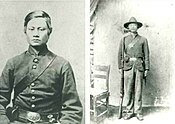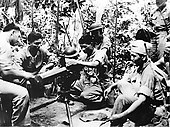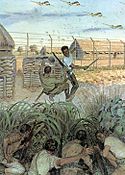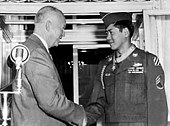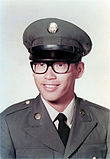Military history of Asian Americans
[15][16] Historian Daniel Sieh states that Asian-Americans during the American Revolutionary War, while few, were fairly widespread throughout the colonies, numbering at least a hundred during the 1770s and 1780s.
"[19] In the diaries of American naval captain John Paul Jones, Malays were listed as one of the ethnicities who were part of the crew of the USS Bonhomme Richard during the Battle of Flamborough Head in 1779.
[23][24][25] Indian-American Charles J. Simons was the first Asian-American awarded the Medal of Honor, for his actions during the American Civil War in the Battle of the Crater in 1864.
William C. Lutter, born in Moulmein, Burma in c. 1840, enlisted in New York for one year as a United States Navy sailor in September 1862.
[27] In 1861, a Chinese American by the name of John Tomney joined the New York Infantry,[4] eventually dying of wounds received at the Battle of Gettysburg in 1863.
[25][33][34] Joseph Pierce (his chosen name) was brought to the U.S. from China by his adoptive father, Connecticut ship captain and Far East trader Amos Peck.
[28] From 1862 to 1865, Pierce fought in pivotal battles of the war, fighting in major campaigns from Antietam[29] to Gettysburg to Lee's surrender at Appomattox Court House.
[43][23] More than a hundred documented Native Hawaiians also served in the Civil War, however due to poor record keeping of non-white combatants, the origin of some participants like Prince Romerson have been claimed by both the Filipino and Native Hawaiian communities as many are listed under anglicised names such as "John Boy" with no other information other than as being from "The Sandwich Islands" with dark eyes, hair and complexion.
[44] Anthony F. Gomez, who was born in Lahore in 1837 as Conjee Rustumjee Cohoujee Bey to an aristocratic Parsi family, joined the United States Navy in 1863 after settling in Brooklyn, New York and converting to Christianity, serving during the Civil War.
After the Civil War, he moved to San Francisco in 1867, married a local woman, and worked for the Navy until his death in 1911 from pneumonia.
He became a naturalized American citizen after the war and moved back to Thailand to become a drill master for the then newly-created Royal Siamese Army.
[6] In 1915, Fireman Second Class Telesforo Trinidad, along with Ensign Robert Webster Cary, was awarded the Medal of Honor for saving fellow crewmembers when the boiler of the USS San Diego exploded.
[71] A large number Chinese Mexicans assisted U.S. forces in Mexico during the expedition and upon its completion in early 1917, they were threatened with hanging by Villa.
Private Tomas Mateo Claudio, who had studied at the University of Nevada and became the first, and only, Filipino American to die during the war, being killed at Château-Thierry in 1918;[77] Private Henry Chinn who was killed in action in the Argonne Forest while serving in the "Lost Battalion";[78] Sergeant Sing Kee, another member of the Lost Battalion, who was awarded the Distinguished Service Cross;[79] and Sergeant Major Tokutaro Nishimura Slocum who served in the 328th Infantry Regiment, 82d Infantry Division.
[93] The U.S. officially remained neutral, but Americans became involved in combat while serving in other countries' militaries in units such as the Flying Tigers in China and the Eagle Squadrons that served with the Royal Air Force shortly after the Battle of Britain;[94] U.S. forces also provided logistic support through the cash and carry program, and by undertaking convoy escort duties in the Atlantic.
[95] Following the Japanese attack on Pearl Harbor in December 1941, the U.S. officially declared war,[96] and from that point on Asian Americans were on the front lines as U.S. civilians.
[108] The combat chronicle of the regiment became a highly storied one, resulting in it becoming one of the most decorated units in the European Theater,[105] taking part in numerous actions in Italy, France and Germany, including the liberation of Dachau concentration camp.
[112]: 201 Additionally, Japanese Americans also contributed to the war effort in the Pacific Front serving in the Military Intelligence Service, helping with the decoding of Japanese intelligence and the rebuilding of occupied Japan;[113] the first Asian American women to enter the U.S. military served within this unit through the Women's Army Corps.
[97] On 5 October 2010, Congress created the Congressional Gold Medal recognizing the 442nd Regimental Combat Team and the 100th Infantry Battalion, as well as the 6,000 Japanese Americans who served in the Military Intelligence Service during the war.
[139] These soldiers were subjected to discrimination during their time training at Camp Beale and Fort Ord, sometimes being mistaken for Japanese Americans when off base.
He went on to serve in the mainly Japanese American 442nd Infantry Regiment,[160] and he was subsequently awarded the Distinguished Service Cross for his actions at the Battle of Anzio.
[161] The only Korean American to be awarded that medal during the war,[162] he also received a Silver Star and Purple Heart for actions earlier in the campaign.
[164] As of 8 March 2012, he is the only Korean American to achieve the status of ace,[165] and for his actions, Ohr received several medals including the Silver Star with one bronze oak leaf cluster.
[163] Fita-Fita Guard – native Samoans recruited into the US Naval Reserve to help maintain law and order in Samoan Islands from 1900 to 1952 Philippine Scouts – an integral part of the US Army made up of native Filipinos; first organized in 1901, they also fought on the Bataan Peninsula during WWII 442nd Infantry Regiment – later known as the 100th Battalion; an Army unit made of mostly Japanese Americans that fought in the Europe during WWII; one of the most highly decorated regiments with 21 Medal of Honor recipients; among the troops that liberated concentration camps near Dachau 14th Air Force Chinese American Composite Wing – the ‘Flying Tigers’; created during WWII as a bomber and fighter group; consisted of pilots from both the US and China; deployed to the Pacific Theater Korean Augmentation to the US Army (KATUSA) – the severe shortage of front-line soldiers led to the formation of KATUSA during the Korean War; they were Korean stragglers who joined US Army units in the battlefield, primarily for rations; some also acted as interpreters and enhanced US combat readiness.
[166] That same year, Truman signed the Rescission Act of 1946, which denied Filipinos who served during World War II in the Commonwealth military and guerrillas, benefits that were afforded to other veterans.
[177] Walter Tsukamoto, who was first commissioned in 1927 and entered active duty in 1943, was sent from occupation duty in Japan to Korea in 1950 and was promoted to lieutenant colonel, the first Asian American to achieve that rank in the Army Judge Advocate General's Corps, served as the senior ranking judge advocate for X Corps and was awarded two Bronze Star Medals for his service in Korea.
[197] Recent trends show that Asian Americans, particularly those from California, are enlisting at rates greater than their proportion of population; they are more likely to take up non-combat jobs.
[205] As of April 2017[update], out of the 2,346 deaths that have occurred in Operation Enduring Freedom, 62 have been Asian Americans (47 Soldiers, 8 Marines, 6 Sailors, and 1 Airman).
[211][212] In 2011, Private Danny Chen and Lance Corporal Harry Lew both committed suicide in Afghanistan following hazing;[213] prosecution of several of their unit members followed.
[219] At the end of that deployment the unit was authorized to wear the 442nd's sleeve insignia on the right shoulder, the first time this had occurred since World War II.

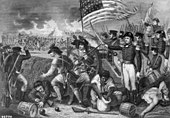
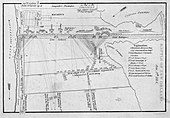
![Joseph Pierce, soldier who served in North during American Civil War.[28][29] to Gettysburg to Lee's surrender at Appomattox Court House.[30] Pierce achieved the highest rank of any Chinese American to serve in the Union Army, reaching the rank of corporal.[31] Pierce's picture hangs in the Gettysburg Museum.[25][32]](http://upload.wikimedia.org/wikipedia/en/thumb/b/b7/Joseph_Pierce_Chinese_Union_Army_Soldier_In_14th_Connecticut_Infantry_Regiment.jpg/115px-Joseph_Pierce_Chinese_Union_Army_Soldier_In_14th_Connecticut_Infantry_Regiment.jpg)
